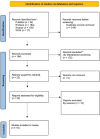Is It Safe to Use Tranexamic Acid for Chronic Subdural Hematoma: A Systematic Review and Meta-Analysis
- PMID: 40485780
- PMCID: PMC12136966
- DOI: 10.1055/s-0044-1801771
Is It Safe to Use Tranexamic Acid for Chronic Subdural Hematoma: A Systematic Review and Meta-Analysis
Abstract
Trans-4-(aminomethyl)-cyclohexane-1-carboxylic acid, also known as tranexamic acid (TXA), has occasionally been used to prevent postoperative recurrence of chronic subdural hematoma (CSDH) after burr hole craniotomy (BC). However, there is a lack of data about the safety and efficacy of TXA administration after BC. This systematic review and meta-analysis adhered to the Cochrane Handbook Standards Preferred Reporting Items for Systematic Reviews and Meta-Analyses guidelines and searching databases up to January 2024 for randomized controlled trials and cohort studies evaluating TXA. The primary outcome was CSDH recurrence and reoperation. The secondary outcome was thrombosis risk and mortality rate. Ten studies were included, comprising 14,836 patients with CSDH who underwent surgical treatment. Five studies were randomized controlled trials, while the other two case series and three cohort studies. The overall pooled hematoma recurrence rate in the group of patients who used TXA as an adjuvant treatment to the surgical intervention (TXA group), compared with patients who only used surgery to treat CSDH (control group), was 0.05 (95% confidence interval [0.03-0.08], p < 0.01), indicating a significant reduction in recurrence with TXA treatment. TXA, as an adjuvant treatment to the surgical intervention, reduces the risk of postoperative hematoma recurrence, reoperation, thromboembolic complication, and mortality related to CSDH after BC in elderly patients.
Keywords: chronic subdural hematoma; craniotomy; subdural hematoma; tranexamic acid.
Asian Congress of Neurological Surgeons. This is an open access article published by Thieme under the terms of the Creative Commons Attribution-NonDerivative-NonCommercial License, permitting copying and reproduction so long as the original work is given appropriate credit. Contents may not be used for commercial purposes, or adapted, remixed, transformed or built upon. ( https://creativecommons.org/licenses/by-nc-nd/4.0/ ).
Conflict of interest statement
Conflict of Interest None declared.
Figures







Similar articles
-
Adjuvant Tranexamic Acid for Reducing Postoperative Recurrence of Chronic Subdural Hematoma in the Elderly: A Systematic Review and Meta-Analysis.World Neurosurg. 2024 Feb;182:e829-e836. doi: 10.1016/j.wneu.2023.12.054. Epub 2023 Dec 13. World Neurosurg. 2024. PMID: 38101544
-
Administration of Tranexamic Acid After Burr Hole Craniotomy Reduced Postoperative Recurrence of Chronic Subdural Hematoma in a Japanese Regional Population.Neurosurgery. 2023 Nov 1;93(5):1160-1167. doi: 10.1227/neu.0000000000002558. Epub 2023 Jun 8. Neurosurgery. 2023. PMID: 37288980
-
Adjuvant oral tranexamic acid and reoperation after burr hole surgery in patients with chronic subdural hematoma: propensity score-matched analysis using a nationwide inpatient database.J Neurosurg. 2022 Jul 22;138(2):430-436. doi: 10.3171/2022.5.JNS22664. Print 2023 Feb 1. J Neurosurg. 2022. PMID: 35901677
-
Role of Adjunctive Tranexamic Acid in Facilitating Resolution of Chronic Subdural Hematoma after Surgery.J Korean Neurosurg Soc. 2023 Jul;66(4):446-455. doi: 10.3340/jkns.2022.0200. Epub 2022 Nov 3. J Korean Neurosurg Soc. 2023. PMID: 36325752 Free PMC article.
-
Efficacy and safety of tranexamic acid in the management of chronic subdural hematoma: a systematic review and meta-analysis.J Neurosurg. 2024 Apr 5;141(4):945-954. doi: 10.3171/2024.1.JNS232463. Print 2024 Oct 1. J Neurosurg. 2024. PMID: 38579356
References
-
- Mehta V, Harward S C, Sankey E W, Nayar G, Codd P J. Evidence based diagnosis and management of chronic subdural hematoma: a review of the literature. J Clin Neurosci. 2018;50:7–15. - PubMed
-
- Almenawer S A, Farrokhyar F, Hong C et al.Chronic subdural hematoma management: a systematic review and meta-analysis of 34,829 patients. Ann Surg. 2014;259(03):449–457. - PubMed
-
- Liu W, Bakker N A, Groen R JJJ. Chronic subdural hematoma: a systematic review and meta-analysis of surgical procedures. J Neurosurg. 2014;121(03):665–673. - PubMed
-
- Sattari S A, Yang W, Shahbandi A et al.Middle meningeal artery embolization versus conventional management for patients with chronic subdural hematoma: a systematic review and meta-analysis. Neurosurgery. 2023;92(06):1142–1154. - PubMed
Publication types
LinkOut - more resources
Full Text Sources

